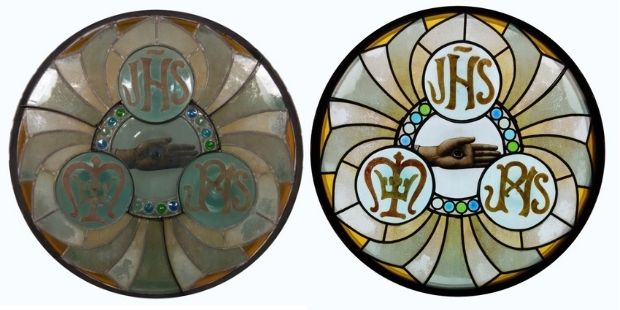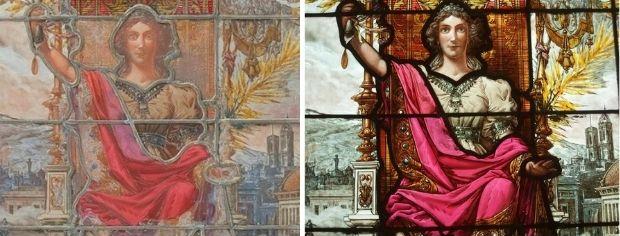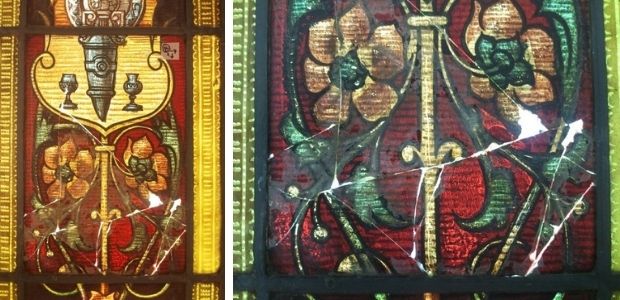Valeria Mamczynski
The museum has a group of technically exquisite stained glass windows that includes some of the most characteristic examples of Catalan Modernisme, a movement in which stained glass, like all the other decorative arts, played an important part. In recent years several conservation-restoration projects have been carried out on the stained glass windows in the collection, all of them from the most famous stained glass workshops of the period.
In 2013 the stained glass window Allegory of the Fine Arts Exhibition was restored, designed by Josep Lluís Pellicer Fenyé and made by the Antoni Rigalt y C.ª workshop (Barcelona, 1890-1903), which is currently on loan and exhibited in the Museu del Disseny. In 2015 two stained glass windows made by the workshop of Eudald Ramon Amigó were restored: Rosace with the Eternal Eye and Saint Michael the Archangel, both of them designed by Enric Monserdà and Antoni Gaudí and exhibited in the museum’s Modern Art rooms. Finally, in 2018, one of the windows belonging to Casa Trinxet was restored, The Virgin as a Young Girl, designed by Joaquim Mir and made in the Rigalt, Granell i Cia. workshops in Barcelona. It subsequently appeared in the exhibition that visited several cities in Japan, “Barcelona: the City of Artistic Miracles”. All these works show outstanding stained glass-making techniques, of high quality for the period, each with their own peculiarities and challenges.

When it comes to approaching a restoration, the conservators-restorers are guided by the same principles and ethical codes of our profession. We make an assessment of the state of preservation of the piece and we document its characteristics. We determine the necessary treatments for its restoration and we analyse the materials most suitable for use that do not entail any risk for its stability and preservation.
In any case, the diagnosis and the proposal for intervention depend principally on the material the work is made of. A work in wood, stone, metal or any other opaque material is worked on differently to a stained glass window, whose chief characteristic is its translucence. This quality is undoubtedly the main challenge when working on glass, very often coloured or painted on the surface. The criteria for intervention and the choice of materials for restoration will always have to ensure that light can pass through it.

Detail of the female figure in the central panel (without transmitted light (left) and with transmitted light (right).
Of the different techniques for making a stained glass window, which vary according to the period, I shall focus on leaded stained glass. This is the type we find in the large windows of cathedrals and what we see mostly when we pass in front of a Modernista building. Besides the flat glass, the stained glass window is made up of lead lines that run around all the pieces of glass and the edge of the window. These lead lines are soldered together and make up a framework that gives the stained glass window structure and rigidity. In the majority of Modernista leaded stained glass windows we find the putty, which the makers placed between the lead strips and the pieces of glass to strengthen them and make them watertight before placing them in a window.
We also find other materials, generally metallic, for fixing the pieces of glass to their frame or to the building: the iron bars or strips, generally fixed to the panels using wires soldered to the lead lines, which act as cross-pieces and separate the different panels of the stained glass window.
Pathologies and alterations in stained glass windows
The pathologies in stained glass windows depend on the nature of each constituent material, on its composition and its behaviour in relation to its surroundings over time. Some of the most common deffects are glass fractures and sometimes, as a result, the loss of fragments of glass; fractures in the lead that produce the weakening and the loss of structural resistance of the whole framework; the buckling or deformation due to the loss of resistance of the lead framework and other alterations typical of each constituent material.
One of the most habitual procedures in restoration work on stained glass windows is joining broken pieces of glass together. The causes of breakage, one of the most common glass pathologies, may vary: breakages produced by acts of vandalism when the stained glass windows are on the outside, accidental knocks, incorrect handling of the panels when moving them, and also the deterioration of the compositional elements of the stained glass window that may entail, for example, the loss of structural resistance of the framework of lead mesh/net.

Plaqué glass with decoration of grisailles and silver stain, which shows many fractures and was repaired, in the past, by gluing sheets of paper to it to prevent the loss of the glass fragments (Central panel with transmitted light)
In a forthcoming article I shall continue to discuss the restoration of the Museu Nacional’s collection of stained glass windows.
Valeria Mamczynski Guerizoli is a freelance conservator specialized in glass conservation. She studied at the Barcelona School of Glass (Fundació Centre del Vidre de Barcelona) from 2003 to 2005, doing the special subject of Stained Glass Windows and Glass Sculptures. She received her Fine Arts degree from the University of Barcelona in 2008 and between 2010 and 2011 she was awarded an Andrew W. Mellon Research Fellowship grant at the Metropolitan Museum of Art in New York, where she specialized in the conservation-restoration of glass.
Related links
Restoring the colour of the light: stained glass windows in the Museu Nacional d’Art de Catalunya /2
Restauració i Conservació Preventiva







